Saginaw’s Cherry Slush was one of mid-Michigan’s most popular bands during the 1960s and regular performers at Daniel’s Den, one of the state’s top teen night clubs. The Cherry Slush was also one of the few garage bands from that era to place a single on the charts of the three major trade papers in the 60s, Billboard, Record World, and Cash Box.
Although the city of Saginaw is now plagued with unemployment, crime, and urban blight, it was a still-thriving community in the early 1960s. It had strong links to Michigan’s automobile industry, and it was an important industrial and manufacturing center at that time. During those pre-mall days, the city’s downtown was a mecca for shoppers from all around mid-Michigan and was filled with a wide variety of stores and shops.
Downtown Saginaw was also a magnet for area teens during the 60s. Future Cherry Slush members Dick Coughlin, Mark Burdick, Tom Armbruster, Art Hauffe, and Dan Parsons were all in the 7th grade during the spring of 1964. In a recent interview, Coughlin described Saginaw in those days as “bustling” and said that “you could hardly walk down the street on E. Genessee on a Saturday for all the young people that congregated there”.
The Big Boy restaurant was a major teen hangout and the downtown’s best place for burgers and shakes. Record buying teens could shop at either Howard’s Music or Grinnell’s record department to purchase the latest sounds. There was also Webster’s Shoes where Coughlin and his buddies could procure horseshoe heel plates for their shoes at 25 cents a pair, thereby enabling them to slide down the halls at school – much to the annoyance of teachers and administrators.  Cherry Slush (L to R) Brian Bennett, Gene Bruce, Dan Parsons, Art Hauffe, Dick Coughlin
Cherry Slush (L to R) Brian Bennett, Gene Bruce, Dan Parsons, Art Hauffe, Dick Coughlin
The city of Saginaw is divided by the Saginaw River which runs through the downtown and empties into Saginaw Bay. It is one of the few rivers in the country that flows in a south to north direction. It also served as a dividing line between the races with a mixture of blacks, Latinos, and whites on the east side of the river, while the west side was almost exclusively white. Coughlin, Hauffe, Parsons, and Burdick all attended North Intermediate on the city’s west side and would then go on to Arthur Hill High School. In the mid-1960s Arthur Hill’s student body was almost completely white. Coughlin could only remember two black students attending the school during his years there.
Coughlin said “growing up on Saginaw’s west side during the 60’s was great! The area was very safe. On a summer night you could leave your windows open and your doors unlocked”. The Coughlin house on Monroe Street had a very large porch and it was the main hangout for area kids who were friends of Coughlin or his brother John who was three years older. Coughlin recalled that there was a lot of guitar playing, singing, and cigarette smoking going on almost every day of the week when the weather was warm enough to be outside. After the band was formed, other musicians from the area also started to join the almost daily gatherings on the Coughlin’s porch.
They started their first group in 8th grade during 1964-65 school year and started performing on stage as The Wayfarers, a Kingston Trio-like folk group with a revolving line-up, at school assemblies. Coughlin played a snare drum and cymbal and Burdick played guitar. With Coughlin as the driving force, The Wayfarers quickly evolved into a rock band, inspired by both The Beatles and Beach Boys. Coughlin described himself as a “big Beach Boys fan”, especially drummer Dennis Wilson who he patterned himself after and idolized.
Both Coughlin and Art Hauffe played in the school band in the drum section, but Hauffe agreed to switch to bass so that he could be in Coughlin’s rock group. Early members included Jack Omeing on sax and Gary Colbert on guitar, but the band line-up soon solidified with Dan Parsons on lead vocals, Burdick on lead guitar, Hauffe on bass, Coughlin on drums, and Tom Armbruster, a friend who attended another school, on rhythm guitar.
The change in musical direction necessitated a name change for the band as well. Coughlin suggested The Captives; and it was under that moniker that they got their first gig at the Saginaw St. Andrews High School’s basement cafeteria. The band had rehearsed only about three weeks and they were paid just $5. But it was the first time they had ever been on stage as a rock and roll band, and they loved it.
The first serious bump in the road for The Captives occurred in the fall of 1965 when Armbruster’s father was transferred to Ohio, forcing Tom to leave the band. The Captives continued on as a quartet, covering the latest songs by The Beatles, Rolling Stones, Beach Boys, and The Kinks but they had also found a new influence over the summer, one that would help forge a new identity for the band. 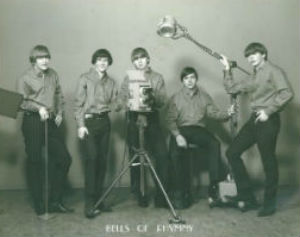 Bells of Rhymny (L to R) Dan Parsons, Dick Coughlin, Art Hauffe, Mark Burdick, Gene Bruce
Bells of Rhymny (L to R) Dan Parsons, Dick Coughlin, Art Hauffe, Mark Burdick, Gene Bruce
The Byrds had exploded onto the national music scene with a folk rock version of Bob Dylan’s “Mr. Tambourine Man” that reached # 1 in the summer of 1965, and they had topped the charts again in the fall with “Turn, Turn, Turn”. The Byrds were being heralded by the music press as America’s answer to The Beatles, and The Captives had started incorporating some Byrds’ songs into their sets. The band was never that crazy about ‘Captives’ as a name, and while grooving to the new “Mr. Tambourine Man” album at Coughlin’s house one evening, they decided on a new Byrds-inspired name instead.
The Bells Of Rhymny band name was taken from the title of a Pete Seeger composition about a Welsh coal mining disaster and how the steeple bells in the town had tolled mournfully in memory of the dead miners. The song had been given an electrified folk rock treatment by The Byrds on the album, featuring the distinctive 12-string guitar of Jim McGuinn. In the fall of 1965, The Byrds even appeared at Daniel’s Den. Since he wasn’t yet 16, Coughlin had to sneak into the Den to see the performance. 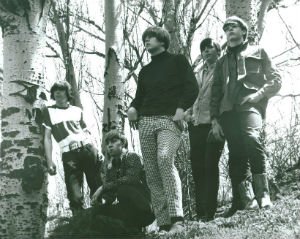 (L to R) Coughlin, Hauffe, Parsons, Burdick, Bruce
(L to R) Coughlin, Hauffe, Parsons, Burdick, Bruce
With their new identity in place, The Bells Of Rhymny needed a second guitar player now more than ever, especially one who could play a 12-string guitar. Their prayers were answered in March of 1966, when they heard about Gene Bruce who attended Douglas MacArthur High School in Saginaw Township, west of the city. Bruce, who was a year older than the others, was hired into the band after one audition. He played a 12-string guitar, and with him on board the band could better duplicate signature Byrds’ songs like “Feel A Whole Lot Better”, “Mr. Tambourine Man”, “All I Really Want To Do”, “Chimes Of Freedom”, and of course, “The Bells Of Rhymny”. Bruce played his first gig with the band at a dance hosted by WKNX DJ Dick Fabian at a school in Zilwaukee, a small city in Saginaw Township.
Not only did the band get Gene Bruce, but they also got his mother Vivian. According to Art Hauffe: “Gene’s mother, Vivian, was a great lady. She’d drive to each of our houses and pick us up for rehearsals almost every day. She’d make us sandwiches and took a real interest in the group. My dad had a station wagon so he was the one who took us to our gigs. Gene’s mother bought us clothes and even got us a choreographer to teach us dance steps.” Dick Coughlin recalled: “Vivian Bruce used to drive the whole band to shows at Roll-Air in Bay City and then wait in the car until the Battle of the Bands or Super Tuesday shows were over, and then drive us back to Saginaw.”
The band’s big break came later in March. Vivian Bruce, who was also acting as the band’s co-manager, received a call from Frank Patrick, owner of Daniel’s Den on State Street. Located on Saginaw’s west side, Daniel’s Den was one of the premier teen night clubs in Michigan. Patrick had been tipped off about the Bells Of Rhymny by Coughlin’s older brother John, who also helped manage the group and was employed as the regular DJ at the Den. 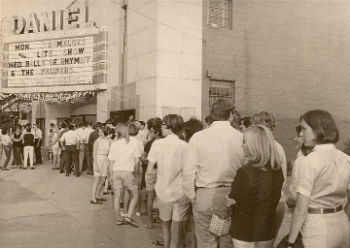 Teens lined up at Daniel's Den
Teens lined up at Daniel's Den
Solely on John Coughlin’s recommendation, Patrick offered The Bells Of Rhymny a Sunday matinee booking at the Den. They would be the opening act for Terry Knight and The Pack. This guaranteed The Bells big exposure. Terry Knight and The Pack had scored several local hit singles, and the band’s latest release, “Better Man Than I”, was topping the charts across Michigan and Bubbling Under nationally in Billboard magazine.
Daniel’s Den had a stellar reputation throughout the country, and presented major national acts like Sonny & Cher, The Shangri-Las, The Kingsmen, The Box Tops, and Gary Lewis & The Playboys. If you were a local band and got booked into the Den, it was like playing the Copa in New York City or one of the top casinos in Las Vegas. It was the local equivalent of the big time – you had arrived!
Dick Coughlin recalled: “Daniel’s Den was great! For kids our age you didn’t have to take a date because there were always plenty of girls there. Frank Patrick would let you smoke, and they had non-alcoholic drinks at the bar that mimicked real alcoholic drinks like rum and cokes and mint juleps. The Den also had pinball machines and pool tables. There was a large crystal ball on the ceiling over the dance floor, which was banked on either side by tables with candles and ashtrays where kids could sit and talk and smoke. But when the bands came on, just about everyone would go and stand in front of the stage”. 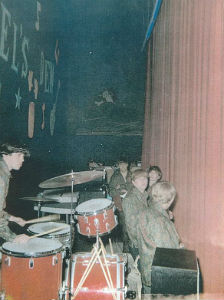 1966: Bells of Rhymny behind the Den's red velvet curtain
1966: Bells of Rhymny behind the Den's red velvet curtain
The Den’s stage had a big, beautiful red velvet curtain that was always closed before the bands came on, and Coughlin said that you were always looking under it to see the bands moving around behind it. He said it was quite a thrill when The Bells got to play there for the first time, opening for Terry Knight and the Pack.
The Bells Of Rhymny got their first mention in the weekly Deb & Jo column on Saturday, August 13, 1966. The two young ladies attended St. Andrews High School and had been writing their music column in the Saginaw News for a year. Their column had all the latest news about area bands and events at Saginaw’s two big teen hotspots, Daniel’s Den and the Y’ A-Go-Go. According to Dick Coughlin, “Deb & Jo’s column was it! If you got mentioned, you were on your way. The big thing was reading their column on Saturday to see if your name was in it”.
On August 13th Deb & Jo wrote, “We went to Gene Bruce’s house a while ago to hear the Bells Of Rhymny. They’re not just there – they’re good and really grab ya (not literally!) They do a lot of Byrds sounds along with The Beatles…..These guys have a lot of talent and can arrange songs to their own liking. They also write songs. Much more about them later.” Deb Harden and Jo Hintz would go on to document the Saginaw rock and roll scene for the next two years in their Deb & Jo column in the Saginaw News.
That summer the band members decided to make a professional recording. They found the Schiell Recording Studio in Bay City in the Yellow Pages. A few weeks earlier, ? and The Mysterians recorded “96 Tears” at the small recording studio Art Schiell had put together. It was in an addition to his home on Raymond Street. “96 Tears” had went on to become a big summer hit in Michigan on the small Pa Go-Go label, and now issued nationally on the Cameo label, it was on its way to the #1 spot on the Billboard Hot 100.
Schiell charged The Bells Of Rhymny $15 an hour. The members of the band set up the session and chipped in for the cost. They recorded two originals, “She’ll Be Back” and “Don’t Walk Away”, at the first session on Schiell’s two-track Magnecord recorder. When Schiell played the tracks back on the large speakers in his studio, the band was thrilled. He burned acetates for them to take back to Saginaw. The band also thought to bring a camera with them to the session and captured the only known photos of a rock band recording with Art Schiell.  (L to R) Parsons, Burdick, Coughlin, Bruce, and Hauffe with the acetate recorded at Art Schiell's studio
(L to R) Parsons, Burdick, Coughlin, Bruce, and Hauffe with the acetate recorded at Art Schiell's studio
In the fall, Bells Of Rhymny returned to Art Schiell’s studio and recorded two more original songs, “Rich Man’s Woman” and “Now I’m Free”. Interested in releasing a single, they took the four acetates of their recordings to Dick Wagner. Wagner was the guitarist, lead singer, and main songwriter for Saginaw’s most popular band, The Bossmen. Wagner, then in his mid-twenties, was the elder statesman of Saginaw’s rock music scene and was idolized by the Bells Of Rhymny. The Bossmen had already released several local hit singles and were one of the biggest draws in mid-Michigan.
They met with Wagner at his upstairs apartment on Phelon Street on Saginaw’s east side. Wagner especially liked the Burdick/Parson composition, “She’ll Be Back”, but suggested a few changes to the recording, including the addition of a fuzz-tone guitar. Wagner agreed to produce a new recording of “She’ll Be Back”, but wanted to do it at the United Sounds Studio in Detroit.
In early January of 1967, the band drove to Detroit with Wagner and recorded the song with United Sounds’ engineer Danny Dallas. For the flipside, The Bells recorded a Wagner-penned novelty tune called “The Wicked Old Witch”. Dick Wagner released the disc a few weeks later on his own Dicto label.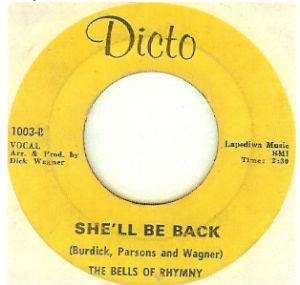
Their debut record got a boost in the Deb & Jo column published on January, 28, 1967. The girls wrote: “The Bells Of Rhymny are about to have their first record released. It’s GREAT! The “A’ side is called “The Wicked Old Witch”; written and produced by Dick Wagner. The “B” side is the serious side and is entitled “She’ll Be Back” and was written by the group. The record is really expected to be a hit, and after hearing it, you will understand why.”
“She’ll Be Back” got a significant amount of airplay on Saginaw’s two biggest AM stations, WKNX and WSAM. Radio airplay provided more name recognition for the band resulting in more bookings and more money for the gigs. The local success of their first record capped off a year that was filled with a lot of rehearsals, combined with $100 a night gigs in high school gymnasiums, converted roller rinks, and even cow barns.
The Bells of Rhymny also played at Daniel’s Den on many occasions, often opening for bigger bands like The Tremeloes from England, The Gentrys, The Amboy Dukes, Richard and The Young Lions, Bob Seger & The Last Heard and many others. The Bells were again mentioned in Deb & Jo’s column on December 31, 1966, after they had won first place and the cash prize in the previous week’s battle of the bands at the Den. They had competed against The Loose Ends, The Prodigal Sons, and The Luvlorns. 
The band members were all under sixteen years of age for those early appearances at Daniel’s Den. Sixteen was the minimum for admittance, so the only time they could legally enter before reaching the magic age was to play a gig there. After playing several times at The Den, The Bells found they were in greater demand in outlying areas. They subsequently played dances at the Sportsman’s Club in Sebewaing, the Arenac Fairgrounds, and the 007 teen night club in the Thumb.
Despite these high notes, disharmony was beginning to creep into the band. To the others, it seemed that guitarist Mark Burdick was becoming increasingly disinterested in playing. Dick Coughlin recalled: “The relationship with Mark Burdick had already started to deteriorate by the Schiell sessions. Mark was more interested in his girlfriend than playing in the band. It became an issue after shows when he wanted to leave right away to be with his girlfriend rather than help breakdown equipment. The rest of the band got tired of tearing down and carrying his guitar and amp.
By this time, Jim Leach had signed on as the band’s co-manager, replacing John Coughlin. Leach was Art Hauffe’s uncle. He was working as the press agent for ? and The Mysterians, and got involved after he heard The Bells practice. Leach was a Journalism and English teacher at Buena Vista High, but was also pursuing a career in show business. Coughlin described how the two worked together, “Vivian was the band’s den mother and she handled the group’s finances. Jim took care of the bookings and publicity.”
The band realized that having an effective team behind them was important if they were going to take the next step and get their records released on a national label. By this time, Dick Wagner had signed The Bossmen to Cameo-Parkway’s subsidiary label, Lucky 11, and was recording the band’s next single at the Audio Recorders studio in Cleveland, Ohio. 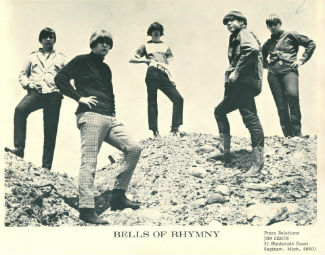 (L to R) Coughlin, Burdick, Parsons, Bruce, Hauffe
(L to R) Coughlin, Burdick, Parsons, Bruce, Hauffe
The Bells would again enlist the writing and producing talents of Dick Wagner to record the song that would prove to be their biggest hit at Audio Recorders in Cleveland. Wagner had written a catchy song for the band called “I Cannot Stop You” for their next single’s A-side. The Audio Recorders studio was located in the basement of an office building in downtown Cleveland and could only be accessed by an outside street level elevator. The studio was relatively small, about the size of a large living room, and contained a Hammond B3 organ with a Leslie speaker.
Dick Wagner produced the Cleveland session with Don White serving as engineer. The Bells made a big switch before starting the recording. Gene Bruce took over the lead guitar position and Mark Burdick played the studio’s Hammond B3 organ. The recording also featured horns. Wagner had written a horn line for the song and Don Sheets was brought in to play the parts. Wagner wrote in his memoir, Not Only Women Bleed, that “the horns made the record happen”; and the resulting master take of “I Cannot Stop You” had hit single written all over it.
For the B-side, the band decided to re-record “Don’t Walk Away”, one of the first songs they had done at the Schiell studio the previous year. After they returned from Cleveland, Jim Leach scheduled another session with Art Schiell, but this time with Dick Wagner producing. Art Hauffe recalled the session: “Wagner suggested that “Don’t Walk Away” needed a bridge, so Parsons and Burdick went outside and came back with something that sounded like Roy Orbison. Wagner also suggested that we sing ‘Please, oh please don’t walk away’ instead of ‘Hey, hey, hey don’t walk away’. That’s how the B side came about. We did it in about an hour.”
The issue with Mark Burdick came to a head soon after. Dick Coughlin explained: “For the rest of the band – the priority was the band, not girlfriends.” Resentment among band members over Burdick’s priorities reached the point that Coughlin, who was the leader within the band, fired him from the group shortly after the first single was recorded. The parting was not amicable. Burdick was understandably bitter about being booted from the band and his friendships with all concerned were severed. Coughlin said that the last time he and the rest of the band saw Mark Burdick was when they all graduated from Arthur Hill in June of 1969.
The band hired Charlie Woodward to replace Burdick. Woodward was playing in another Saginaw rock band at the time called The Dignitaries, and was also a big fan of The Beach Boys. Woodward played rhythm guitar and he had Carl Wilson’s Chuck Berry-inspired surf guitar licks down pat.
Woodward was not the only change. By the late summer of 1967, the band started thinking about altering their name. Their music had branched out beyond doing Byrds’ covers, and they were trying to come up with a name that would somehow match the change in their sound. On their way north to play an engagement in Rose City, they stopped a place called Dottie’s Dairy Bar for refreshments. There, on a sign, was an advertisement for a drink called a Cherry Slush. After some joking around about it, they realized that they had inadvertently stumbled upon the perfect new name.
The band announced the change during their next gig at the Den. They played their first set as The Bells Of Rhymny and the second as The Cherry Slush. They had gained a new name but lost Charlie Woodward in the fall when he enrolled in college. He was quickly replaced by Brian Bennett. Dick Coughlin was dating Bennett’s cousin; and when he mentioned that they were looking for someone to take Charlie’s place, she told him about Brian who was playing keyboards for a band called The Sons Of Sound. One night after playing a gig at the Den, Coughlin and the rest of the band drove out to see him and his band play at a reception in Freeland. Impressed, they hired him into The Cherry Slush on the spot. 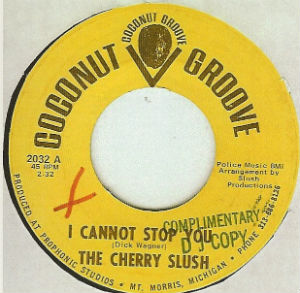
“I Cannot Stop You” had been put on the shelf while the band went through its personnel changes and Jim Leach searched for a record deal. Leach found a couple of record entrepreneurs named Phil Doyle and Paul Potts who ran a small label called Prophonics Records, located in Mt. Morris, Michigan, who very much wanted to release “I Cannot Stop You”. Although The Cherry Slush was hoping to sign with a major label, Leach negotiated a deal with Doyle and Potts to release the record on their pop-based Coconut Groove subsidiary label. The pact had a provision that if a national label wanted to pick the record up, The Cherry Slush and their recordings would be released from their contract. Also in the deal was a $5,000 lease agreement for the master tape of “I Cannot Stop You”.
It seemed to be a great deal for The Slush, and it worked to their advantage at first. The record was released on Coconut Groove regionally and caused a sensation in Michigan. After getting lots of airplay on two of mid-Michigan’s most influential AM stations, Flint’s WTAC and Saginaw’s WKNX, the offers started to come in. At one time, ATCO, Mercury, Cameo-Parkway, Laurie, and Bang all wanted the record. Dick Coughlin said that the band was leaning toward signing with Laurie Records because the label had produced recent hits by both The Royal Guardsmen and The Music Explosion.
USA, a small Chicago label, also wanted “I Cannot Stop You”. The label had a big hit with “Kind Of A Drag” by The Buckinghams in 1967, but then lost the group to Columbia Records at contract renewal time. When Leach and the band traveled to Mt. Morris to discuss the national label decision, they were shocked to discover that Doyle and Potts had already sold their contract to USA without their knowledge or permission. The papers had been signed, and nothing could be done about it. The sweetheart deal they thought they had signed with Prophonics had turned sour. 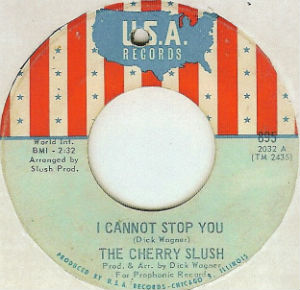
At first it seemed like it might work out. “I Cannot Stop You” had all the signs of becoming a huge hit. Bookings for the band had started pouring in, and The Slush was now able to ask for more money. In addition, the record was getting airplay in major markets including, Chicago, New Orleans, Boston, Cleveland, Philadelphia, Atlanta, Miami, Seattle, Milwaukee, Cincinnati, and went to # 1 in Sarasota, Florida. It was a pick hit in both Cashbox and Billboard magazines, and entered the chart in Record World magazine as # 93 in the nation.
The Cherry Slush flew to Cleveland where they appeared on the popular rock music TV show, Upbeat. They also appeared on Swinging Time with Robin Seymour in Detroit, Swing Lively in Lansing, and The Swinging Majority out of Chicago. Performing on television with the Young Rascals, Smokey Robinson & The Miracles, Joe South, The Outsiders, Peaches & Herb, The Beacon Street Union, and Jay and The Techniques was a teenage band’s dream come true.
On Friday afternoons, when many Arthur Hill students were planning to go to either the Den or the Y’ A-Go-Go over the weekend, the members of The Cherry Slush were making travel plans. The band played gigs in Chicago, Detroit, Louisville, and many places throughout Illinois, Ohio, and Michigan; and they worked with The Gentrys, The Bob Seger System, The New Colony Six, The Shadows of Knight and many others. 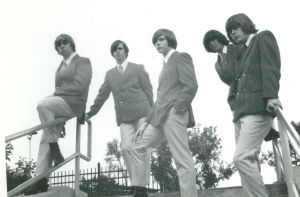 The Cherry Slush
The Cherry Slush
With “I Cannot Stop You” climbing the charts, USA decided to quickly release a second Cherry Slush single. The band would be working with Bob Monaco and Jim Golden at MG Productions in Chicago at the famous Chess Records studio at 2120 South Michigan Avenue. Monaco and Golden had selected the two songs and were producing the session. The engineer was Ron Malo who had worked with The Rolling Stones and most of famous blues artists who recorded for Chess Records.
The A-side was “Day Don’t Come”, a great song but it sounded like it was written for The Buckinghams, not The Cherry Slush. It was an elaborate and very expensive production. USA even brought in the Chicago Symphony to do the instrumental backing tracks. Monaco and Golden ran the show and neither the band nor Jim Leach, who accompanied them to the session, had much input. Unbeknownst to either The Cherry Slush or Leach, the USA label was in dire financial straits at the same time they were recording the single.
“Day Don’t Come” got some positive reviews in the trade papers. Cash Box said: “The new one features a more polished sound with extra appeal that could set the Cherry Slush high on the best seller lists. Scurrying tempo is overlaid with a smooth string arrangement and some very fine vocals on a snappy tempo teen offering.” Billboard stated: “Hard-driving rocker has all the earmarks of a hot chart item. A discotheque winner with a strong vocal workout that spells top sales. Watch this one.” 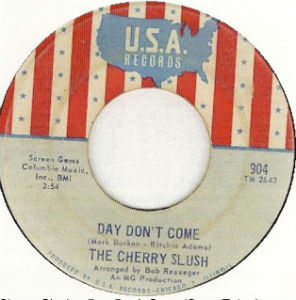
Unfortunately, USA filed for bankruptcy shortly after the release of “Day Don’t Come”, killing the record nationally as well as stalling any additional sales for “I Cannot Stop You”. “Day Don’t Come” did reach # 2 in Saginaw thanks to the band’s loyal hometown fans; but The Slush was both stunned and angry at the way that the rug had been pulled from under them just as it seemed they were on their way to becoming successful on a national level.
ATCO was still interested in The Cherry Slush, and Dick Wagner had written a song called “Who Are You” that he thought would be perfect for the band. The band recorded the song at United Sound in Detroit with Wagner producing but it was never released. Coughlin said that the engineer at United had never worked with a rock band – his recording experience was with orchestras. This fact contributed to what both the band and Wagner deemed a subpar recording and the proposed ATCO deal fell through. Wagner and his new band, The Frost went on to record “Who Are You” in 1969 for “Frost Music”, their debut album on Vanguard Records.
Somewhat disheartened, Cherry Slush recorded their next single with Dave Kalmbach at the Great Lakes Recording Studio in Sparta, Michigan. The A-side of the single was a cover of The Beatles’ “Birthday” which had been first released on the “The Beatles/White Album” in late 1968. The B-side was a cover of the early Byrds’ song, “Feel A Whole Lot Better”. Coughlin said they enjoyed recording at the Sparta Studio and got a good sound. 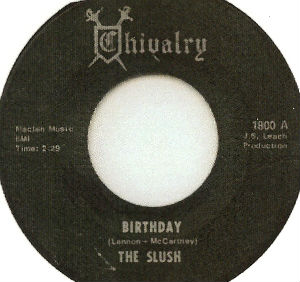
Strangely enough, the 45 was issued on Jim Leach’s Chivalry label as by ‘The Slush’ instead of The Cherry Slush in 1969. Coughlin couldn’t remember why they didn’t use Cherry Slush, but said that the band might have thought that 'Cherry Slush' was kind of a teeny bopper or bubblegum name at a time when the music scene was changing and the teen dance clubs were starting to die out. Whatever the reason, it seems like a poor decision that wasted the name recognition they had built up during the past year. “Birthday” was a local hit, but a band from Wisconsin called Underground Sunshine got the national hit during the summer of 1969 when their cover of “Birthday” peaked at # 26 on Billboard’s Hot 100.
The end of The Cherry Slush came in 1969. Shortly before its demise, the band had added brass to their sound by hiring Rick Bailey and Bob Steckert on horns. With the possibility of recording for a major label no longer in the picture, The Cherry Slush played one last gig at Daniel’s Den and then called it quits.
Most of the band graduated from high school in June of 1969. Gene Bruce had graduated one year earlier. Now out of high school, the band members were faced with the military draft and the possibility of going to Vietnam. Coughlin drew a low number in the draft lottery (# 36) and was drafted shortly after turning 18. He was sent to Ft. Wayne for his pre-induction physical but failed because of a heart murmur. Dan Parsons enlisted in the Navy. Gene Bruce, Art Hauffe, and Charlie Woodward all were deferred from the military when they enrolled in college. Brian Bennett had a high lottery number and was not drafted. 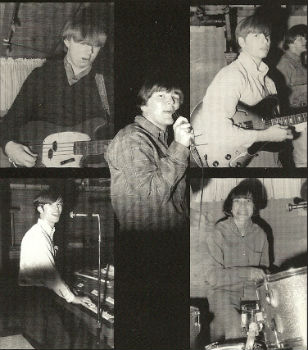 Cherry Slush (clockwise from top left) A. Hauffe, D. Parsons, G. Bruce, D. Coughlin, B. Bennett.
Cherry Slush (clockwise from top left) A. Hauffe, D. Parsons, G. Bruce, D. Coughlin, B. Bennett.
Dan Parsons attended Loyola Law School after the being discharged from the Navy and is working as an attorney in Chicago. Gene worked for his father’s company, Bruce Cartage, eventually becoming vice-president of the business before his untimely death in 2009. Gene was predeceased by his mother Vivian in 2005.
Brian Bennett worked as a car salesman at Burt Watson’s dealership. He was the only band member to stay active as a working musician. Sadly, Brian Bennett pased away in 2016 after a lengthy illness. Art Hauffe lived in Florida. He owned Southern Granite Products and is a broker for two cabinet companies before passing away. Charlie Woodward retired from State Farm Insurance after running his own agency in Florida.
Dick Coughlin began working at Saginaw General Hospital, first as an orderly, and then after receiving training, he became an ER Technician. Dick retired after 32 years working at Saginaw General and Covenant Health Care. Mark Burdick lives in Essexville and and worked with the Michigan Department of Human Services. Dick’s older brother, John Coughlin, was disc jockey “Sammy J” at WSAM and then worked as a news reporter at WSGW until his death in 2007.
Jim Leach stayed in show business. He eventually moved to Hollywood and became “James St. James, The Real Jimmy Hollywood” with a syndicated radio show that is heard across the country. He has stayed in contact with Dick Coughlin over the years as both his manager and publicist. In addition, Leach has appointed Coughlin the radio show's associate producer for the Midwest and Canada.
In 2001, The Cherry Slush released “Looking Back”, an 8 song CD on Dick Wagner’s WMG Records that featured the songs that comprised the A and B-sides of their four singles. That same year Gene Bruce and Wagner put together a reunion show at a park in Freeland. It was the last time the Cherry Slush played together.
In 2013, The Cherry Slush was voted into the Michigan Rock and Roll Legends online Hall of Fame. Both “I Cannot Stop You” and “Day Don’t Come” were voted Legendary Michigan Songs in 2012.
Dr. J. Recommends: "Looking Back" 2001 CD, TCS Productions, WMG Records.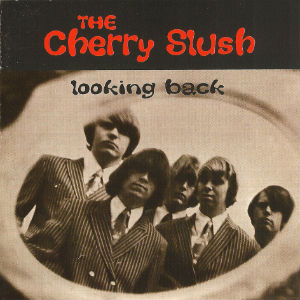
This is a collection of the four singles the band released on the Dicto, USA, and Chivalry labels. The A-sides are particularly strong, but the B-sides are very good as well. With a financially stable record company, "I Cannot Stop You" and "Day Don't Come" could have been significant hits, and they still stand today as two of the top garage rock singles released during the 1960s.

